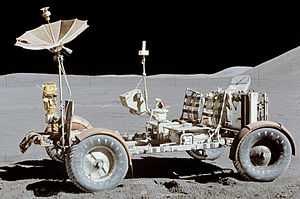Lunar rover

A lunar rover or Moon rover is a space exploration vehicle (rover) designed to move across the surface of the Moon. Some rovers have been designed to transport members of a human spaceflight crew, such as the Apollo Lunar Roving Vehicle; others have been partially or fully autonomous robots, such as Lunokhod 1 and Yutu. As of 2013, three countries have had rovers on the Moon: the Soviet Union, the United States and China.
History
Lunokhod 1
.jpg)
Lunokhod 1 was the first of two unmanned lunar rovers landed on the moon by the Soviet Union as part of its Lunokhod program. The spacecraft which carried Lunokhod 1 was named Luna 17. Lunokhod was the first roving remote-controlled robot to land on another celestial body. Lunokhod 1 held the durability record for space rovers for more than 30 years.
Lunokhod 2
Lunokhod 2 (Луноход) was the second of two unmanned lunar rovers landed on the Moon by the Soviet Union as part of the Lunokhod program. The Luna 21 spacecraft landed on the Moon and deployed the second Soviet lunar rover Lunokhod 2. The objectives of the mission were to collect images of the lunar surface, examine ambient light levels to determine the feasibility of astronomical observations from the Moon, perform laser ranging experiments, observe solar X-rays, measure local magnetic fields, and study the soil mechanics of the lunar surface material.
Apollo Lunar Roving Vehicle

The Lunar Roving Vehicle (LRV) was a battery-powered four-wheeled rover used on the Moon during the last three missions of the American Apollo program (15, 16, and 17) during 1971 and 1972. The LRV could carry one or two astronauts, their equipment, and lunar samples.
Yutu

Yutu is a Chinese lunar rover which launched on 1 December 2013 and landed on 14 December 2013 as part of the Chang'e 3 mission. It is China's first lunar rover, part of the second phase of the Chinese Lunar Exploration Program undertaken by China National Space Administration (CNSA).[1] The lunar rover is called Yutu, or Jade Rabbit, a name selected in an online poll.[2]
The Yutu rover might be the world's first true hibernating robot on the moon.[3]
Proposed missions
Barcelona Moon Team rover
Barcelona Moon Team is a team participating in the Google Lunar X Prize, with a planned launch date for the mission in June 2015.
Astrobotic Technology rover
Astrobotic Technology, a private company based in Pittsburgh, Pennsylvania, United States, plans to send a rover to the Moon in October 2015, as part of the Google Lunar X Prize.
Chang'e 4
Chinese mission with a planned launch date for 2015.
Chandrayaan-II
The Chandrayaan II mission is the first lunar rover mission by India, consisting of a lunar orbiter and a lunar lander. The rover weighing 50 kg, will have six wheels and will be running on solar power. It will land near one of the poles and will operate for a year, roving up to 150 km at a maximum speed of 360 m/h. The proposed launch date of the mission is 2017.
ATHLETE
.jpg)
NASA's plans for future moon missions call for rovers that have a far longer range than the Apollo rovers.[4] The All-Terrain Hex-Legged Extra-Terrestrial Explorer (ATHLETE) is a six-legged robotic lunar rover test-bed under development by the Jet Propulsion Laboratory (JPL). ATHLETE is a testbed for systems and is designed for use on the Moon.[5] The system is in development along with NASA's Johnson and Ames Centers, Stanford University and Boeing.[6] ATHLETE is designed, for maximum efficiency, to be able to both roll and walk over a wide range of terrains.[5]
Scarab
Scarab is a new generation lunar rover designed to assist astronauts, take rock and mineral samples, and explore the lunar surface.[7][8] It is being developed by the Robotics Institute of Carnegie Mellon University, supported by NASA.
Space Exploration Vehicle
The SEV is a proposed successor to the original Lunar Roving Vehicle from the Apollo missions. It combines a living module, as it has a pressurized cabin containing a small bathroom and space for 2 astronauts (4 in case of emergency), and a small truck.
See also
References
- ↑ Chang’e 3: The Chinese Rover Mission
- ↑ Ramzy, Austin (26 November 2013). "China to Send ‘Jade Rabbit’ Rover to the Moon". The New York Times. Retrieved 2013-12-02.
- ↑ "China's Yutu Rover Might Be The World's First True Hibernating Robot" from InvestorSpot.com
- ↑ NASA's Space Exploration Vehicle (SEV)
- ↑ 5.0 5.1 "The ATHLETE Rover". JPL. 2010-02-25.
- ↑ "The ATHLETE Rover". NASA. 2010-02-25.
- ↑ "NASA Day on the Hill". NASA.
- ↑ "Snakes, Rovers and Googly Eyes: New Robot Masters Take Many Forms". Wired. 2008-04-04.
External links
| |||||||||||||||||||||||||